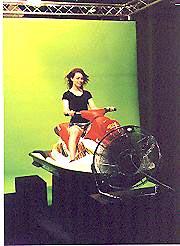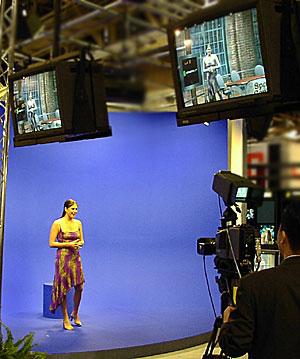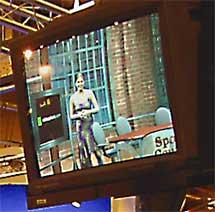|
Module 26 - 2 |
Updated: 07/24/2005 |
|
Virtual Reality Sets Within the last few years computer-generated graphics have moved into a whole new arena: simulating complete settings. These are referred to as virtual reality sets. The color of the background that can be used for keying is normally
either green (above) or blue (below). The color can be electronically removed and
another video source inserted (keyed in) to replace it. Consider the illustrations above. A model in a studio sitting in front of a blue or green background can be made to appear within a computer-generated fantasy scene. Although this is a fantasy scene, very realistic settings can now be computer generated and keyed in behind talent. (Note the computer generated scene below.
On the left a model with a fan
in front of her is made to look as if she is bouncing along on a jet-ski
in the ocean.
A video recording of the ocean and surrounding scenery taken from
the back of a speeding boat is keyed into the green area behind her. This
results in a realistic
scene, and the model doesn't even have to get her hair wet! If it stopped here, the
"realism" would be confined to one point of view. But in the real world cameras
move and perspectives change. Let's look at an example. Note the woman standing against the blue background on the right. Now look in the two monitors at the top of the photo and notice that a complete setting has been inserted (keyed into) this live scene. Although the woman may not be able to actually sit down in the chairs seen in the setting, she can convincing walk behind them and they will pass in front of her body as she moves. However, she can also sit down on the blue box shown behind her in this photo, which, if things are positioned correctly, can make it appear that she is sitting down on one of the virtual reality chairs. The camera can pan, tilt, and zoom on her, and the keyed-in setting will shift appropriately. This Why use virtual reality
settings? Virtual reality sets are also easy to change-no gallons of paint involved, just a series of mouse clicks. In the not-to-distant future we'll be talking about totally realistic virtual (computer-generated) actors and on-camera talent. Even today we have realistic looking heroes on the Internet and in films that were born and raised within a computer. No union contracts; no worry about working overtime or on weekends; no personal accommodations or "artistic differences" to contend with; and no 20-million dollar salaries!
The little white dots on the male and female subjects in this photo are used in motion tracking. A video camera tracks the movement of these subjects (actually, the dots) and transfers the data to animated figures in a computer. The action is normally transferred to a elemental wire frame version of the animated drawings. Once the action is established, the computer can be used to "flesh out" the drawings to resemble any desired figure. This process not only greatly simplifies the process of animating figures, but since the white dots represent numerous points of movement, it results in more realistic action. In the next section we'll introduce a new topic, and one that is central to the medium of television: lighting. |





 enlargement
of the TV monitor above the woman shows the complete effect in more detail as seen
from the camera's position.
enlargement
of the TV monitor above the woman shows the complete effect in more detail as seen
from the camera's position.